In this post we will comprehensively discuss how to build a 500 watt inverter circuit with an integrated automatic battery charger stage.
Further in the article we will also learn how to upgrade the system for higher loads and how to enhance ot into a pure sine wave version.
This 500 watt power inverter will convert a 12 V DC or 24 V DC from a lead acid battery to 220 V or 120 V AC, which can be used for powering all types of loads, right from CFL lights, LED bulbs, fans, heaters, motors, pumps, mixers, computer, and so on.
Basic Design
An inverter can be designed in many different ways, simply by replacing the oscillator stage with another type of oscillator stage, as per user preference.
The oscillator stage is basically an astable multivibrator which could be using ICs or transistors.
Although an astable based oscillator can be designed in various ways, we will use the IC 4047 option here since it is a versatile, accurate and a specialized astable chip designed specifically for applications like inverers.
Using IC 4047
Making any inverter using the IC 4047 is probably the most recommended option due to high accuracy and readability of the IC. The device is a versatile oscillator IC which provides a dual push pull or flip flop output across its pin10 and pin11, and also a single square wave output at pin13.

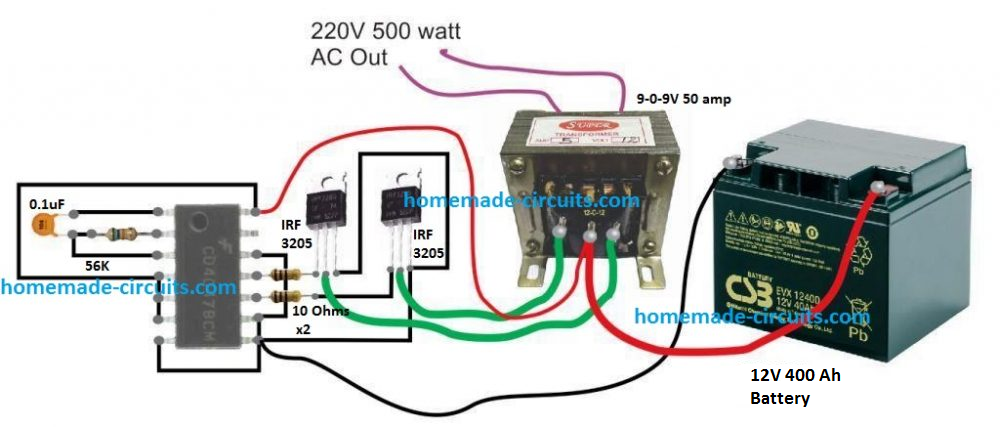
A basic 500 watt inverter with a square wave output can be as simple as above to build. However, to upgrade it with a battery charger we may have to employ a charger transformer rated appropriately as per the battery specifications.
Before learning the charger configuration let's first get acquainted with the battery specification required for this project.
From one of our previous post we know that the more appropriate charging and discharging rate of a lead acid battery should be at 0.1C rate or at a supply current that's 10 time less than the battery Ah rating. This implies that to get a minimum of 7 hours back up at 500 watt load, the battery Ah could be calculated in the following manner
Operational current required for a 500 watt load from a 12V battery will be 500 / 12 = 41 Amps approximately
This 41 amps needs to last for 7 hours, implies that the battery Ah must be = 41 x 7 = 287 Ah. However, in real life this will will need to be at least 350 Ah.
For a 24 V battery this may come down to 50% less at 200 Ah. This is exactly why a higher operational voltage is always advised as the wattage rating of the inverter gets on the higher side.
Using 24 V Battery
In order to keep the battery and the transformer size smaller and cables thinner, you may want to use a 24 V battery for operainf the proposed 500 watt design.
The basic design would remain as is, except a 7812 IC added to the IC 4047 circuit, as shown below:
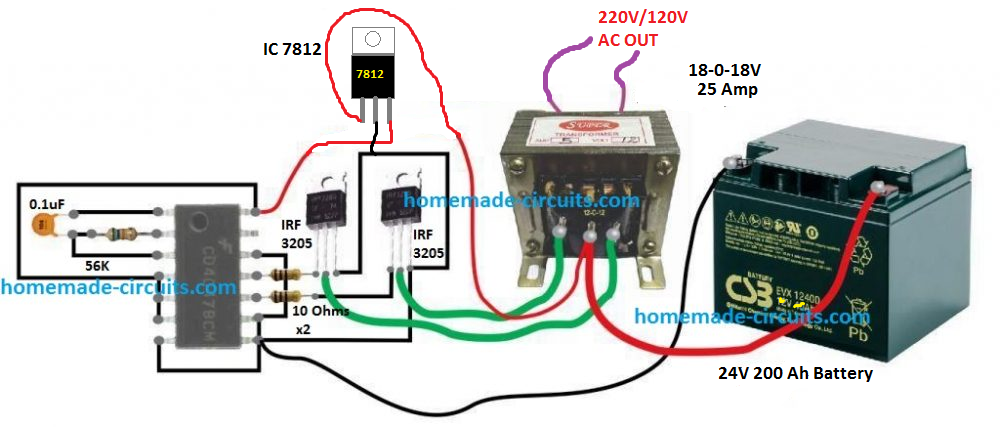
Schematic Diagram

Battery Charger
To keep the design simple yet effective, I have avoided the use an automatic cut off for the battery charger here, and have also ensured a single common transformer is used for the inverter and the charger operations.
The complete circuit diagram for the proposed 500 watt inverter with battery charger can be seen below:
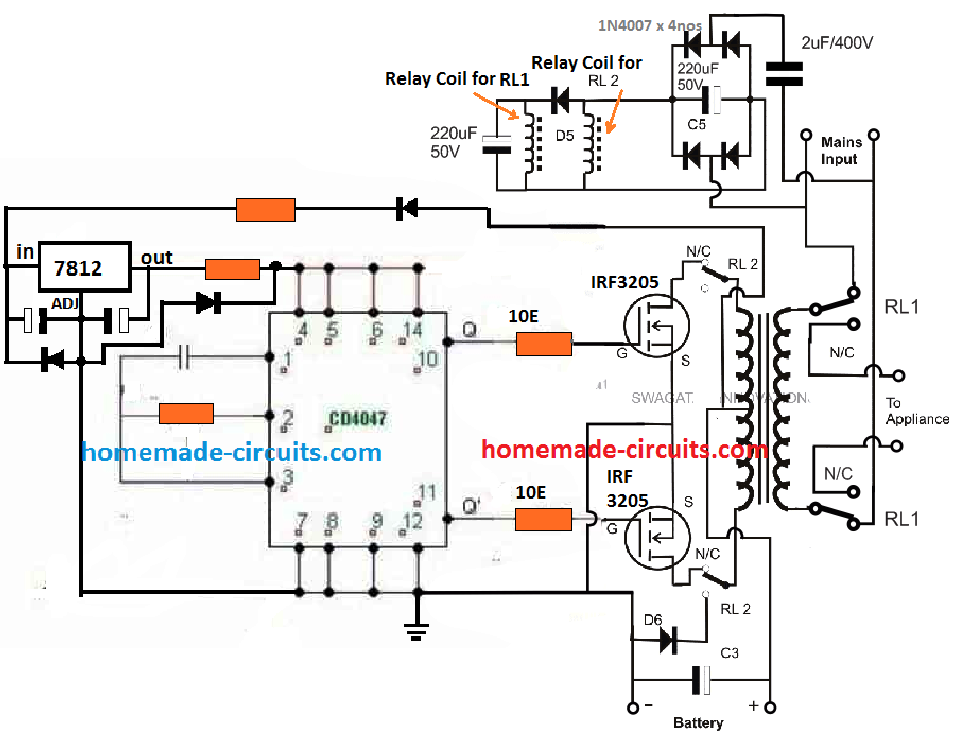
The same concept has been already elaborately discussed in one of the other related posts, which you can refer to for additional information.
Basically, the inverter uses the same transformer for charging the battery and for converting the battery power to 220 V AC output. The operation is implemented through a relay changeover network, that alternately changes the transformer winding to charging mode and inverter mode.
How it Works
When grid mains AC is not available, the relay contacts are positioned at their respective N/C points (normally closed). This connects the drains of the MOSFETs with the transformer primary, and the appliances or the load connect with the secondary of the transformer.
The unit gets into inverter mode and begins generating the required 220V AC or 120 V AC from the battery.
The relay coils are powered from a simple crude transformerless (capacitive) power supply circuit using a 2uF / 400V dropping capacitor.
The supply is not required to be stabilized or well regulated because the load is in the form of the relay coils which are quite heavy duty and will easily withstand the switch ON surge from the 2uF capacitor.
The coil for RL1 relay which controls the mains AC side of the transformer can be seen connected before a blocking diode, while the coil of RL2 which controls the MOSFET side is positioned after the diode and in parallel to a large capacitor.
This is intentionally done to create a small delay effect for RL2, or to ensure RL1 switches ON and OFF prior to RL2. This is for safety concerns, and to ensure that the MOSFETs are never subjected to the reverse charging supply whenever the relay moves from inverter mode to charging mode.
Safety Suggestions
As we know, in any inverter circuit the transformer works like an heavy inductive load. When such a heavy inductive load is switched with a frequency, it's bound to generate a massive amount current spikes which may be potentially dangerous for the sensitive electronics and the involved ICs.
To ensure proper safety to the electronic stage, it may be important to modify the 7812 section in the following manner:
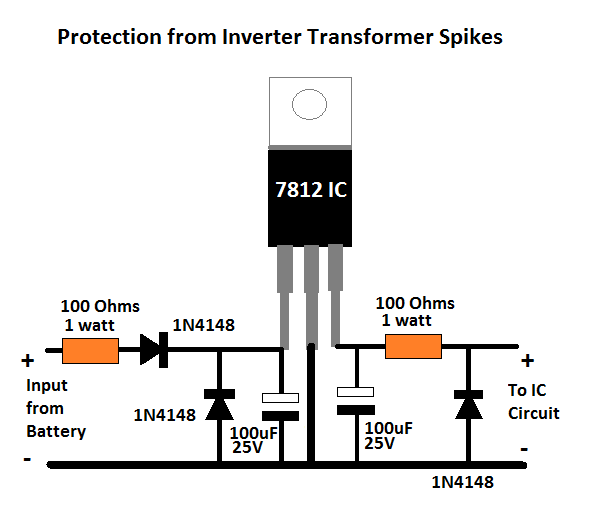
For a 12V application, you can reduce the above spike protection circuit to the following version:
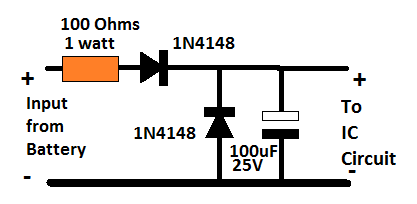
Battery, MOSFET and Transformer Determine the Wattage
We have discussed this many times through different posts that it is the transformer, the battery, and the MOSFET ratings that actually decide how much power an inverter can produce.
We have already talked about the battery calculations in the previous paragraphs, now let's see how the transformer can be calculated for complementing the required power output.
It is actually very simple. Since the voltage is supposed to be 24 V, and power 500 watts, dividing 500 with 24 gives 20.83 amps. Meaning the transformer amp rating must be above 21 amps, preferably up to 25 amps.
However, since we are using the same transformer for both charging and inverter modes, we have to select the voltage in such a way that it suits both the operations optimally.
A 20-0-20 V for the primary side appears to be a good compromise, in fact it is the ideally suited rating for the overall working of the inverter across both the modes.
Since, only one half winding is used for charging the battery, the 20 V RMS rating of the transformer can be used for getting a 20 x 1.41 = 28.2 V peak Dc across the battery with the help of the associated filter capacitor connected across the battery terminals. This voltage will charge the battery at good rate and at the correct speed.
In the inverter mode, when the battery is at around 26 V, will allow the inverter output to be at 24/26 = 220 / Out
Out = 238 V
This looks a healthy output while th battery is optimally charged, and even when the battery drops to 23 V, the output can be expected to sustain a healthy 210V
Calculating MOSFET: MOSFETs basically work like switches that must not burn while switching rated amount of current, and also must not heat up due to increased resistance to switching currents.
To satisfy the above aspects, we have to make sure that the current handling capacity or the ID spec of the MOSFET is well over 25 amps for our 500 watt inverter. Also to prevent high dissipation and inefficient switching the MOSFET's RDSon spec must be as low as possible.
The device shown in the diagram is IRF3205, which has an ID of 110 amp and RDSon of 8 milliohms (0.008 Ohms), which actually looks quite impressive and perfectly suitable for this inverter project.
Parts List
To make the above 500 watt inverter with battery charger, you will need the following bill of materials:
- IC 4047 = 1
- Resistors
- 56K = 1
- 10 ohms = 2
- Capacitor 0.1uF = 1
- Capacitor 4700uF / 50 V = 1 (across the battery terminals)
- MOSFETs IRF3205 = 2
- Diode 20 amp = 1
- Heatsink for the MOSFETs = Large Finned Type
- Blocking Diode Across MOSFETs Drain/Source = 1N5402 (Please connect them across drain/source of each MOSFET for added protection against reverse EMF from the transformer primary. Cathode will go to the drain pin.
- Relay DPDT 40 amp = 2 nos
Upgrading to Modified Sinewave Inverter
The square wave version discussed above can be effectively converted into a modified sinewave 500 watt inverter circuit with much improved output waveform.
For this we use the age old IC 555 and IC 741 combination for manufacturing the intended sine waveform.
The complete circuit with battery charger is given below:
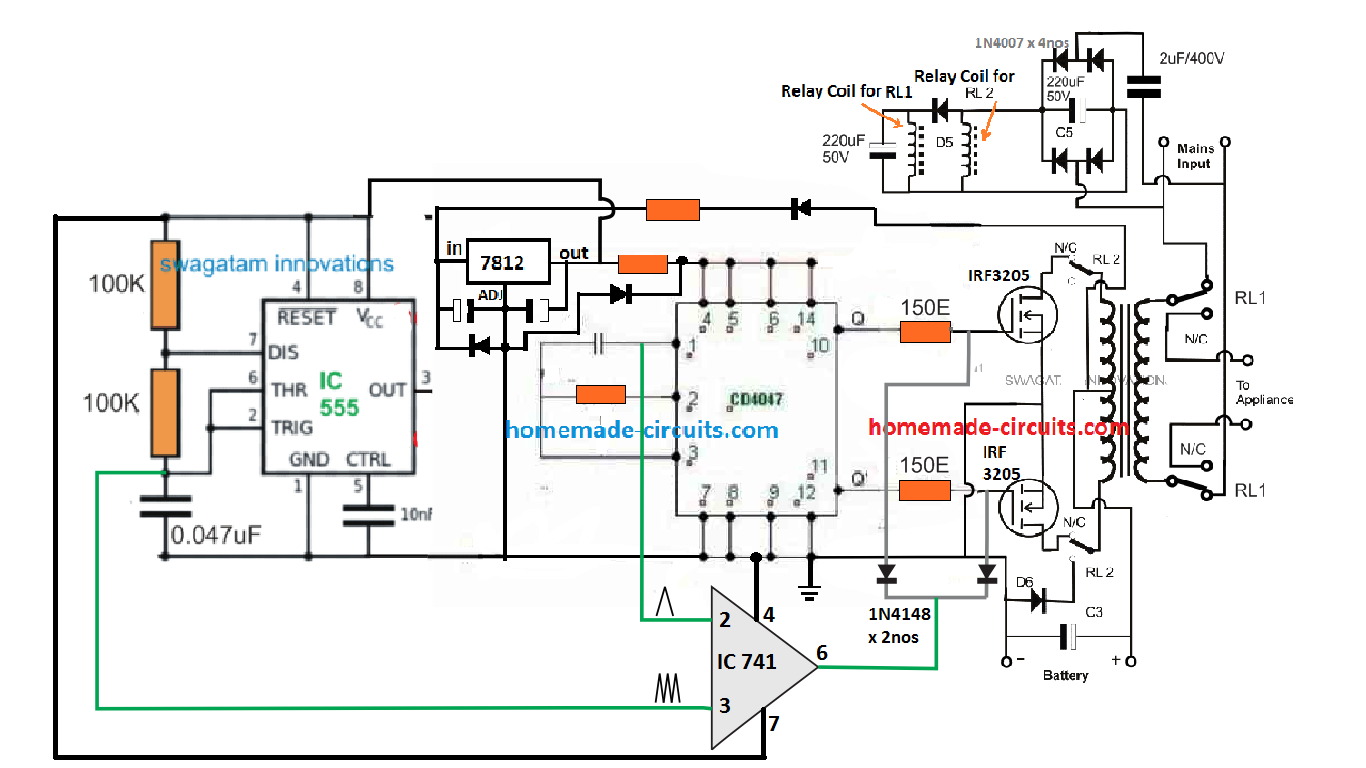
The idea is the same which has been applied in a few of the other sinewave inverter designs in this website. It is to chop the gate of the power MOSFETs with calculated SPWM so that a replicated high current SPWM is oscillated across the push pull winding of the transformer primary.
The IC 741 is used as a comparator which compares two triangle waves across its two inputs. The slow base triangle wave is acquired from the IC 4047 Ct pin, while the fast triangle wave is derived from an external IC 555 astable stage. The result is a calculated SPWM at pin6 of the IC 741. This SPWM is chopped at the gates of the power MOSFETs which is switching by the transformer at the same SPWM frequency.
This results in the secondary side with a pure sinewave output (after some filtration).
Full Bridge Design
The full bridge version for the above concept ca be built using the below given configuration:
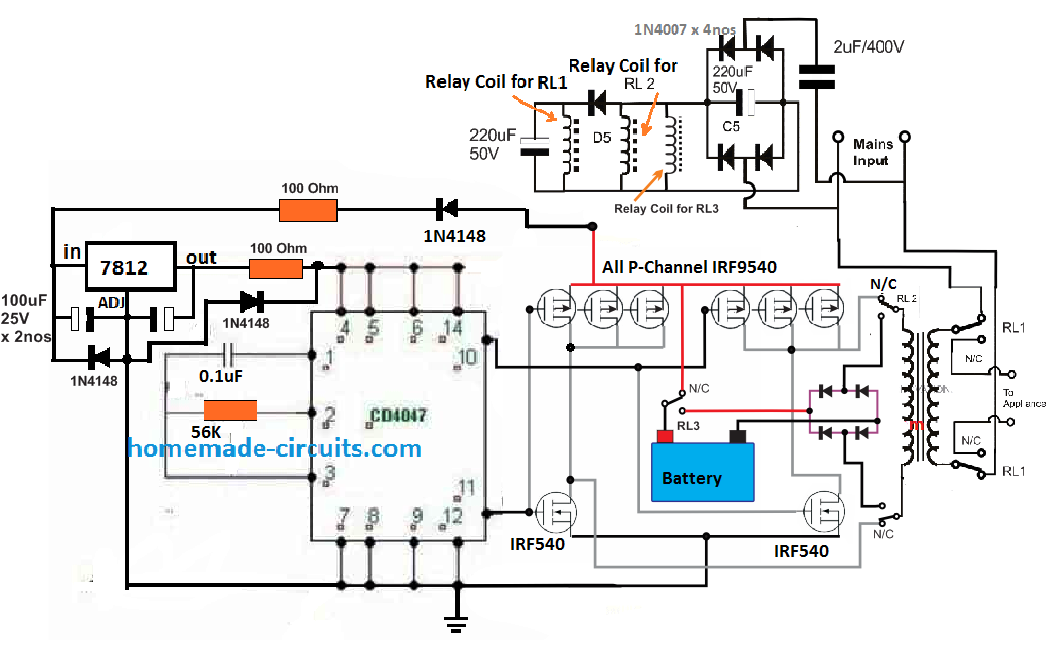
For sake simplicity, an automatic battery cut off is not included, so it is recommend to switched OFF the supply as soon as the battery voltage reaches the full charge level. Or alternatively you may add an appropriately filament bulb in series with the charging positive line of the battery, to ensure a safe charging for the battery.
If you have questions or doubts regarding the above concept, the comment box below is all yours.

Have Questions? Please Leave a Comment. I have answered over 50,000. Kindly ensure the comments are related to the above topic.
Hello sir, I build another 24v inverter using a round transformer 500w rated 20v-0-20v. I hv two 200ah batteries in series. The circuit I built is using 14 MOSFETs meaning 7 each side. The challenge am seeing is that it drains the battery faster without load than when with the load. This is contrary to the first inverter I built using two 100ah in series when I was using 10 MOSFETs 5pcs each side. I now have 200ah batteries and that round transformer(500w) so what could be the problem? Do i increase it to 22-0-22 or I decrease the number of MOSFETs to 10 or what can be adjusted sir?🙏🙏
Hello Morris,
Please connect an ammeter in series with the battery positive and monitor the current consumption with load and without load.
It will help you to assess the real problem…actually without a schematic of the circuit it can be difficult for me to judge the fault.
Now between 20-0-20 and 22-0-22 which one of the two can draw more power from the batteries assuming the two transformers are of the same wattage? Or what is the difference there?
Thanks.
20-0-20V will draw more current than 22-0-22V transformer, simply because the 20V winding has less resistance than the 22V transformer.
Ok thanks. So 22-0-22 stands the best for inverter and will at least last with the battery compared to 20-0-20??? Secondly, can u refer me to a simple and efficient inverter circuit or oscillator using 4047 or sg3525. I bought two 200ah batteries. We have power failure every time here sir.
Thanks.
It will depend on your battery voltage, the transformer primary voltage must be always slightly lower than the battery voltage, provided the inverter is not a PWM inverter.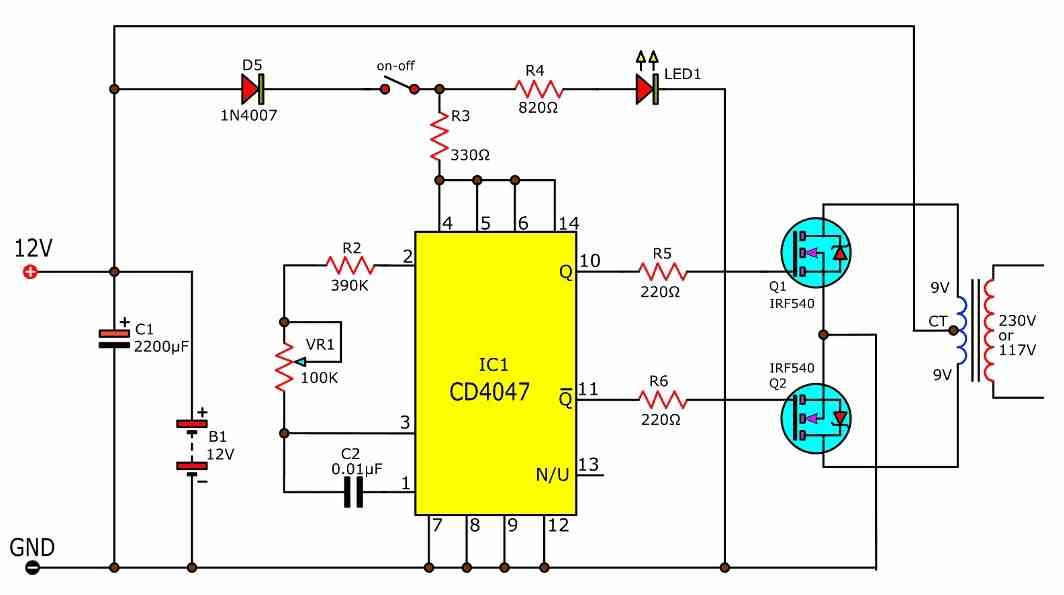
You can try this simple 4047 inverter circuit:
Make sure add a 12V zener diode across the IC supply terminals.
Ok sir. Do u have a diagram too using sg 3525 with a standby indicator and whn it’s switched on the indicator goes off?( Silent oscillator) please refer 🙏🙏
Thanks.
Hello Morris,
sorry, i am not sure how to implement a standby LED indicator for the SG3525, i will investigate it and if I find it will surely let you know….
Thanks sir. But do u have a design of oscillator using sg3525…the perfect one and very silent whn inverter is on? If u hv have that inverter circuit pliz refer.
Thanks
Hi Morris,
You can find the best possible designs in the datasheet of the IC, you can also find good designs in the following article. The IC is nor responsible for the noise, the transformer is responsible…it will generate noise if it is not wound correctly or not clamped tightly with the cabinet.
https://www.homemade-circuits.com/sg3525-pure-sinewave-inverter-circuit/
Hello, please I need the circuit diagram with the components value written besides each of the components because am confused with the diagram
Which circuit are you referring to?
This type of inverter, can it’s supply voltage be directly from a solar panel?
Yes, any DC to AC inverter can be used with a solar panel.
Hello my teacher, I have a circuit like this of yours 👆above. Now can I use 10 ohms resistors connecting gates of the Mosfets instead of 100 ohms and work perfectly? Or what would be the effect? Can it affect efficiency of the inverter or it’s just ok?
Thanks.
Hello Morris,
The resistor is just to safeguard the MOSFET from abrupt voltage spikes, and is actually optional, since the MOSFETs are mostly not impacted by such spikes across the gates.
Also, these gate resistors must be dimensioned according to the operating frequency of the MOSFEs.
The resistor value must be reduced as the frequency increases.
So, basically, using 10 ohms will be fine in your case. Alternatively, you can also use 100 ohms and connect reverse diodes across the resistors to make the situation 100% safe and efficient.
why are same atx transformers have 13pin and same 8-9 pins ,so whats they out put voltage
Swagatam, interesting circuit. This renewed my interest in Solar Power systems. A couple of questions if you have a moment.
1). Is there any benefit to GPS locking the frequency of the inverter? This plays into question 2.
2). In a solar home situation, where you have more devices, exceeding 500 watts, would it be better to upsize the components for greater power, or go with multiple 500 watt units for various rooms of a house; hence the reason of GPS lock for stability and aid with devices needing +/- 1 hz precision?
3). Finally, what are people doing when they have systems as large as 20,000 watts for a whole home?
Thanks for the article. I have have a new winter project.
Thank you Frederick,
I do not have sufficient information regarding GPS frequency locking in inverters, so I cannot suggest much on this. However, as far the inverter frequency is concerned, if we use a voltage regulator for the main oscillator IC, the frequency will remain constant always without fail.
2) I think it is better to use separate inverters to maintain higher efficiency.
3) For 20,000 watt requremenet, as mentioned above people can either have a single large inverter or divide into many smaller inverters.
Please help me sir I have connected the circuit but the voltage at the output is very low 0.65v. I do not know why. I want to design an inverter of 500watt or 100watt
Okon, please check the frequencies at pin10 and pin12 and pin13 of the IC 4047. They should be around 50 Hz, 50 Hz and 100 Hz. If you are not getting these frequencies then your IC is faulty or not configured correctly.
I will trying this plz help me sir
Try an easier and smaller diagram first
Reference to my previous comment. I want to use the ups with solar panels.
It is OK, the solar panels must be appropriately rated, according to the UPS power.
Hello @ Swagatam. I have this 12v blue gate ups (BG653 elite pro) that I want to use as a normal inverter. Do I need to change or add something to it? It uses four CS150N03 transistors.
If I want to increase the power output, what can I do to achieve that? Thanks
Hello @Breno1, UPS can work like an inverter, so you can use that inverter for your application. If you want to increase the output power, you will have appropriately increase the transformer power rating and the ratings of the MOSFET or the transistors.
Sir is that above circuit with spwm generator a 50hz inverter?? Secondly is it suitable for 70 crt television and 60watt standing fan
John, you will have to adjust the frequency to 50 Hz through the given preset. Yes it can be used for a CRT TV and a table fan.
Sir but you already used 100k and 0.047uf capacitor for getting the 50hz while then should I use preset for getting 50hz
Yes, you can adjust one of these two components (or both) with a frequency meter to get a 50 Hz output.
The shown value may not be exactly accurate, so please confirm with a frequency meter.
I don’t have multi meter for adjusting frequency. Can I use the above value
Without a frequency meter you cannot confirm the frequency so you will need a frequency meter.
Hello sir! I want to ask this 500 watts inverter that if can be upgraded to 1000 watts? I love the design because of it self-charge battery. What should I add for the said upgrade?
Hello Diltone. I would recommend you to first try the 500 watt version. If you are successful then you can upgrade it to 1000 watts by adding more mosfets in parallel, a bigger transformer and a higher rated battery.
Is this pure or modified sine wave?
It is a square wave inverter
Does your 1kva power inverter article is a pure sine wave sir? Can I use it like electric fan and charging a phone?
Yes, the first circuit from the following article is almost a pure sine wave, and any electrical or electronic load will work with it:
Make This 1KVA (1000 watts) Pure Sine Wave Inverter Circuit
With the 1kva power inverter. Can I add the battery charging on the said circuit?
You can add a separate battery charging system. I would recommend a separate transformer based battery charger circuit.
Do you have that article?
You can try the 3rd circuit from this article, you may have to upgrade the parts depending on the battery specifications:
https://www.homemade-circuits.com/how-to-make-current-controlled-12-volt/
Thank your for keep replying my queries. I really want to build an power inverter and it happen I discover your site which so helpful. I hope you don’t mind if I keep asking some questions concerning about power inverter. So here’s it my other query.hehehe.. can I use car battery or a battery that is specifically for power inverter?
No problem, you can ask your questions, I will try to answer them as much as possible.
Yes you can use a car lead acid battery or any other lead acid battery or any SMF battery to power the inverter.
Okay. Let’s say, if the power inverter is using 12V 100Ah but I’m using more than 100Ah. Does it have a negative effect on the inverter? Like it will burn the electronic component or performing poorly.
Increasing the Ah rating of the battery will never harm the inverter, instead it will help to increase the backup time of the inverter output. The inverter will be harmed if the battery voltage is increased.
Okay. Thank you for that information. Somehow I learn little by little now. My next question is, how long the battery would last? I know its depend on the usage but I just want to have an idea if it will last like 12 hours while using it only for lightning at night.
The Ah value roughly suggests the appropriate full charge or full discharge time of the battery and the recommended load current.
You can learn more about this in the following article under the heading: “What does Ah Signify”
https://www.homemade-circuits.com/high-current-10-to-20-amp-automatic/
Can I use toroidal transformer aside from the traditional E and I core tranny?
Yes, you can use a torroidal transformer, it is more efficient than the EI type transformers.
can we use 12 volts output for battery charging instead of 24 volts .and how many volts coil of RL1 to RL3.
Can you please tell me which circuit are you referring to?
that is my first time, your innovates is vary very interested thanks so much
Thank you!
This is a tested design.
Please comment under the following article for more info:
https://www.homemade-circuits.com/modified-sine-wave-inverter-circuit-2/
thank you sir for answering all my questions can i use this circuit diagram that you show me for my 300watt freezer
John, which circuit diagram are you referring to? Please post your questions under the relevant thread so that I can understand the sequence of replies.
sir can i use that first diagram to power my 70watt CRT television
The first diagram will produce square wave which is not suitable for operating CRT TV. You can try the following design instead:
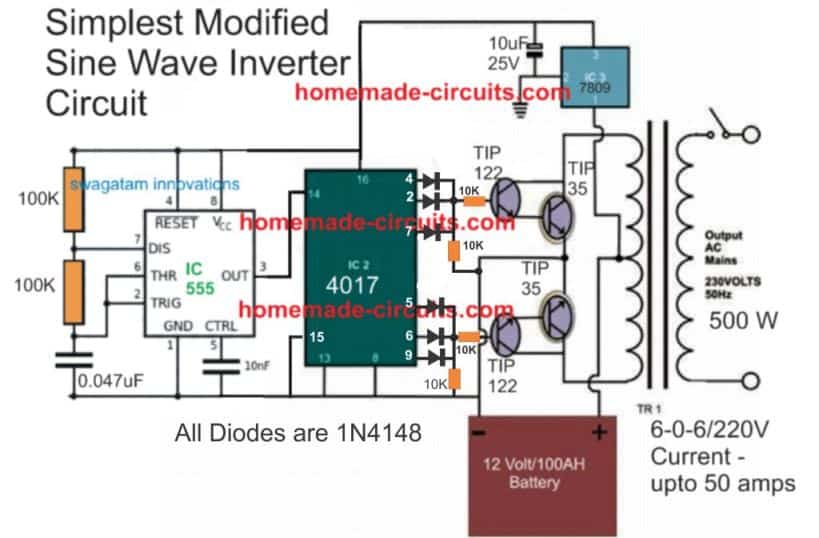
hi ing,, i finished in circuit..upgrade to modified sine wave inverter.
fit the 555 at 400hz and the CD40 47 at 50hz. but the adjustment with a multitester that I had to measure frequency, I tried with a ceiling fan and it no longer has noise like whistling that it did with the square wave one, but the problem does not raise all the ac voltage, 132V
NOTE: do not adjust with oscilloscope
Hi Felix,
You will need an oscilloscope to check and optimize the SPWM waveform, otherwise you cannot complete this sine wave inverter.
A multimeter alone will not work for this project.
How much AC do you want to have at the output, is it 220V?
How much are you getting without the op amp integration with the mosfet?
How much AC do you want to have at the output, is it 220V?
Here in Paraguay everything is 220V. I need 220Vac output.
How much do you get without integrating the operational amplifier with the mosfet?
Yes. I tried without the 741 and without the 555… I tried like this, THE SIMPLEST THING.
No load at 305 vol output and CD4047 frequency at 50 Hz (adjusted with multimeter) and works great even I tried the Watson ceiling fan, which is 220Vac-80W with
7 speeds 1 to 7.
When connected to 1, which is the maximum speed, it drops to 222V from 305 to 280mA consumption.
But to my surprise, I tried it on a TRC color TV of 14″ 90W and…..it worked.
THEN WHY DOESN’T I RAISE EVERYTHING IN VOLTAGE,,, WITH AN OSCILLOSCOPE WOULD BE THE SOLUTION,,, MY TRANSPORT IS 120 W WINDING 230V 10+10V
OK, that sounds great! I am glad you could build the basic inverter perfectly.
So your question is why the output voltage drops when you add the 741/555 sine wave stage to the 4047 circuit, right?
I would strongly recommend to use an oscilloscope to first confirm the SPWM waveform, this step will confirm that your op amp circuit is generating the sine PWM correctly.
Also remember that when a PWM is added it reduces the RMS value of the output voltage causing the voltage to drop.
The remedy is to reduce the primary winding voltage spec accordingly.
For this, you can measure the average DC at the gates of the mosfets. Then use the same voltage for the primary side winding of the transformer.
For example if the average DC at the mosfet gates is 6V, and battery is 12 V then use a 6-0-6V transformer. If the battery is 24 V then use a 12-0-12V transformer.
This modification will raise the output voltage to the correct required levels after the PWM is added.
But before this make sure to confirm the waveform with an oscilloscope.
For my experiments I use the very handy DSO138 oscilloscope, which is small, cheap and perfectly suitable for these applications.
Ing… I already set 400 hz, I put a 10nf capacitor for the 0.047uf, and a preset of 500k ohm in exchange for the 100k ohm resistor, then I will comment on the tests.
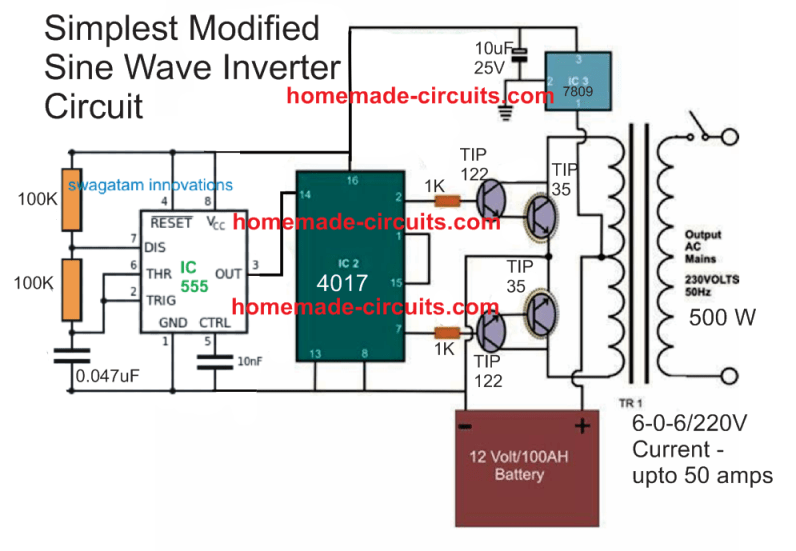
Now I ask now for this other circuit:
1- What frequency should I adjust the 555 before injecting to pin 14 of the CD4017.
2- In this case, the frequency should I adjust on pin 3 of the 555…?
For the simplest modified inverter design, the frequency of the 555 IC at pin#3 should be 100 Hz, But make sure to confirm the actual frequency at the output of the transformer.
Hi Eng. E I made the change of the 100k resistor that goes to pin 4 and 8 of the 555. E and pin 7, I put a 500k variable resistor to vary the frequency of the 555 to 400hz but it only varies from 25hz to 111hz it should lower the value of the capacitor 0.047uf.
Ye, in that case you can try lowering the value of 0.047uF capacitor until you get around 400 Hz.
Ok sir, I will try the power Darlington transistor like as you said. Thanks slot.
OK, no problem!
Hello sir everything is connected correctly and there is no load at the output, like you said using Tip 122&Tip 35 in Darlington mode pls explain what you mean by that.
The MOSFETs could be faulty in that case. You can use the power transistors as they are connected in the following diagram:

Good day sir, sir i bought 4 IRf260 mosfet when ever I connect the ossicillator to the gate the frequency drop from 55 to 45hz, I later drive the mosfet with transistor bc 557& bc547 and the frequency stop dropping, but the mosfet keep heating up, I use enough heat sink. So what could be the problem. I use 12v 150ah I measured the battery volt l’m getting 12.65v with digital multimeter. Pls sir l’m waiting for your response.
Hello Youngking,
If you have connected the MOSFET pinouts correctly and if the MOSFETS are good then they should not heat up at all, unless the inverter is loaded with a high output load.
There may be a possibility that your MOSFETs have gone faulty. I would recommend you build the inverter using power BJTs, for example using a combination of TIP122 and TIP35 in Darlington mode, or 2N2222 and TIP35/2N3055 in darlington mode to check the actual working of the inverter, because BJTs are not as unpredictable as MOSFETs and will not become faulty unless shorted out.
Ing.,,,, my greetings and thanks ,,,,, I will use for 220Vac 50hz
In the part of…Updating to a modified sine wave inverter ,,
1..The circuit could be powered with a 9 volt regulator (7809 ) the CD4047,, 555,, 741.
2,, How much Hz should be adjusted the 555 that will receive the 741 and where to measure… pin 6…?
3..How many Hz should the 4047 be set to at 100Hz…? for 50Hz output
Thank you Felix,
Yes 7809 can be used for powering all the ICs.
555 can adjusted to produce 400 Hz across the capacitor 0.047uF. Measure it across this capacitor.
4047 must set at 50 Hz, you can measure it across one of the output pins (pin10 or 11) and ground.
Please remember that you will need an oscilloscope to check the various waveforms, otherwise it can be impossible to build this circuit.
Thank you very much Ing… for the prompt response… I already made the whole circuit, I just need to verify it with an oscilloscope. adjust the frequencies with a multitester..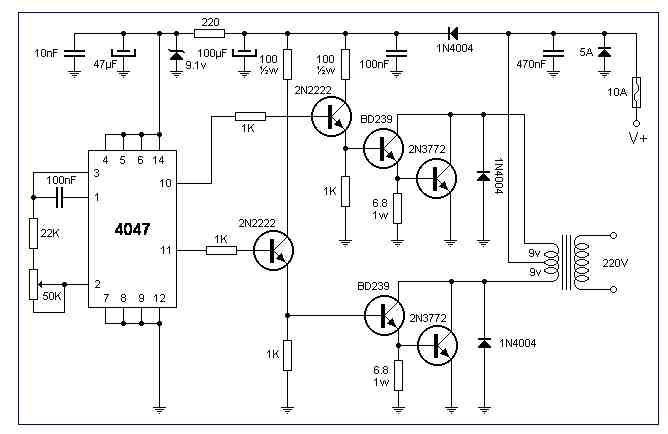 now
now
1..Could be used for electrical appliances, floor fan, ceiling fan, tv, refrigerator.
2 IMPORTANT….!! I made this design years ago and it worked with my ceiling fan.
modify like this,
with the same square wave 4047, simple with 2 irf3205 and it works very well, but could it affect the fan? which is totally inductive, WHY?… the fan stopped working at high speed and only turned slowly, it no longer worked well… Believing it was something else, some time later I used the inverter and it affected another wahson ceiling fan.
Hi Felix,
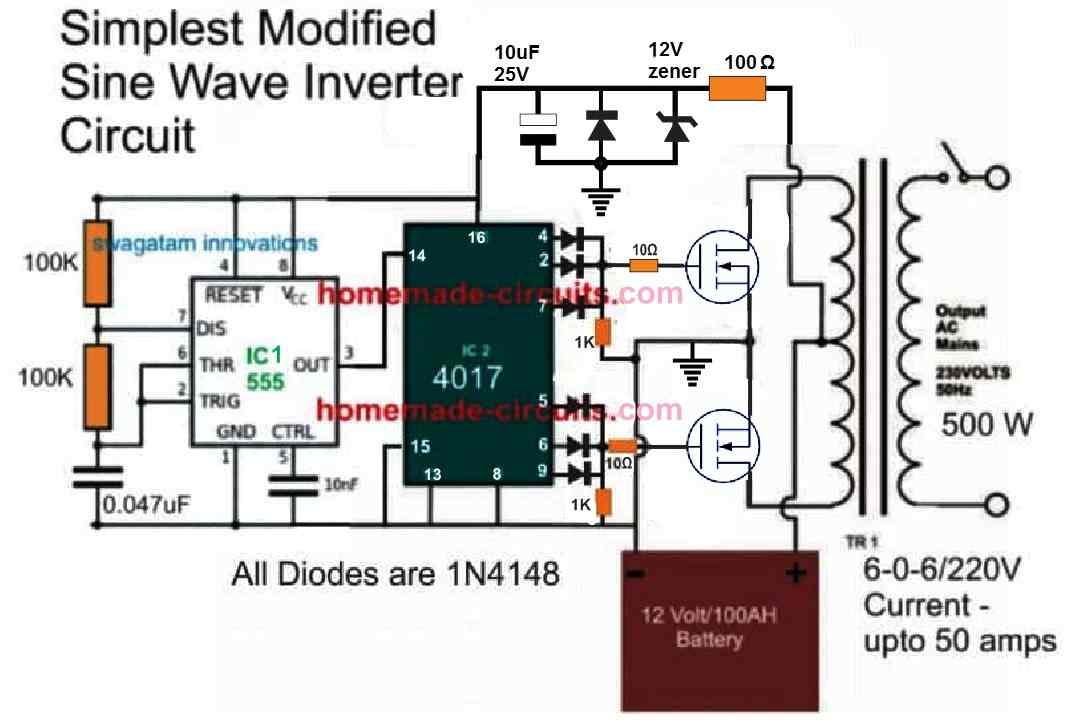
Try adding a 3uF/400V PPC capacitor at the output of the transformer and see whether the fan works correctly or not with this modification.
I think a square wave inverter might not work correctly with a inductive/capacitive ceiling fan.
In that case I can give a simpler modified sine wave inverter diagram which you can try with your fan. Here’s the link for the simple yet very efficient modified sine wave inverter circuit:
Thank you very much Ing… for always being attentive to the questions AND FOR THE ANSWERS THANK YOU… I already did the whole circuit.
1. HOW, WHERE DO I SEND A PHOTO TO SHARE?
Adjust the frequency of the CD4047 with a multitester at 50 Hz.
I ASK…the 555 to adjust to 400Hz, should I replace the 100k ohm…? that is between pin 7 and 2 with 6 and a capacitor that goes to pin 741, for a preset to adjust…?
I just need to verify THE WAVEFORM AND FREQUENCY with an oscilloscope.
REMEMBERING: I MADE THE CIRCUIT LIKE THIS, I ONLY ADJUSTED THE CD4047 TO 50Hz AND I REALIZED THAT WHEN ADJUSTING ITS FREQUENCY THE FREQ ALSO VARYED FROM 555…IN PIN 2 WITH 6…
The next project will be the one you sent me… BUT I HAD ALREADY DONE THE PREVIOUS
https://www.homemade-circuits.com/modified-sine-wave-inverter-circuit-2/
That sounds great Felix, thank you for trying this circuit.
You can send the images to my email hitman2008 @ live . in
I will check it out and post them in the above article.
Thank you Ing.. in these days I WILL SEND THE PHOTOS, DATA AND PROOFS OF THE INVESTOR.
I ONLY HAVE ONE QUESTION LEFT..,,!! for the tests and finish definitively.
1- To adjust the 555 to 400Hz, should I replace the 100k ohm…? by a preset to adjust the frequency between pin 7-2 and 6 with the 0.047uf capacitor going to pin 3 of the 741.
Hi Felix,
To make the 555 frequency adjustable, you can replace the upper 100K resistor with a 500K pot. Replace the 100K which is connected between pin#7 and the positive line. Remember, don’t forget to connect a 10K in series with this pot.
Hello swagatam, I’m confused with fan operation in an inverter. Some inverters have fans that takes air in while others takes out and some even doesn’t have a fan. So what the best way to fix a fan in an inverter.
Hello shafii, According to me the best way is to throw air on the devices which can help to keep the devices cooler.
Full bridge circuit, irf9540 are all gates on 1, 2 & 3 common (as 4,5 & 6)? Is heat sink on mosfet connected to gate? Looked at spec sheet but cannot get the answer. ( first time using mosfets!)!
Thankyou.
Yes the gates are connected in common for the p-channel mosfet groups. Heatsink should be mounted on the body of the mosfet.
If you are using mosfets for the first time then this full bridge inverter project is not for you. It is recommended for the experts only.
Thank you for your response,I will go for the BJts and check the result. So the transformer you talk about does it mean that the 12-0-12 transformer won’t do the job, but I will still go for the one you mentioned in no distance time.
As long as your battery is above 12V, the 12-0-12 transformer will be able to generate 220V output, but once the battery voltage drops below 12V, the transformer output will also drop below 200 V, which won’t be appropriate for the load.
Hello sir, when ever I remove the mosfet from ic Sg3524 the frequency remain 50hz. So how can I dectect the mosfet that is faulty and another thing I measure my battery voltage with multimeter l’m getting 12v and my transformer is 12-0-12/ 230v.
That means your mosfets are not good. You can try replacing them Darlington BJTs and check the response. BJTs are more reliable than mosfets and will provide you with proper results.
See this example circuit which uses BJTs instead of mosfets
https://www.homemade-circuits.com/48-v-inverter-circuit/
….And for a 12V battery your transformer must be preferably rated at 9-0-9V
Hello sir, when I switch on my inverter without load the frequency keep droppin g from 50Hz to 45Hz, and the positive battery do get hot or could it be that I use single wire for the positive line. Please what could be the issues.
Hello Youngking, it could be due to some short circuit in the circuit maybe due to a faulty mosfet.
Disconnect the mosfets from the 4047 IC and check the frequency at the output of the IC. If it remains stable without the mosfets then the fault could be with the mosfets.
Hello Swagatam, I want u to lecture me here. I have bought two pieces 12v 100ah and I want to build a 24v modified sine wave inverter. I want to use the first circuit in one of the modified sine wave inverter circuits. My question is, if I use 5mosfets each side will that consume the battery very fast or I reduce the namba to 4 or 3 on each side? Am using irf2805 which has 175A maximum. Advise to get the right efficiency. Thanks ????
Hello Morris,
The mosfets are like switches. They must be rated appropriately to handle the load. So the number of mosfets must be selected depending on how much wattage of load you want to apply at the output. The mosfet will conduct more current and drain the battery faster if the load at the output is high. If the load is lower then the battery will drain slower accordingly.
So if I use 5 on each side is just ok if my output load is low it’ll just drain the battery slowly? And it’s also ok if my load is high therefore it will be able to handle that load capacity? Secondly, pliz refer me to your best automatic solar charger cut off circuit to the battery. Lastly, can u design a circuit that can connect two batteries in parallel to be charged if u have one panel then upon full charge threshold the circuit reconnects in series connection to be used in a 24v inverter ???????? find out and tell me
The battery draining will depend on the load, not the mosfets. The mosfet wattage must be higher than the max load wattage so that the mosfets do not burn.
You can refer to the last circuit from the following article for the charger. Just increase the input voltage according to the battery voltage.
Sorry this changeover circuit can be difficult to design, can’t figure out at this moment.
Simple 3.7 V Li-Ion Battery Charger Circuit
Are you getting the automatic comment notifications from my site?
Am not getting automatic comments plus am not getting my mail inbox I have to come to website directly i don’t know what’s wrong
Yes, my email notification is malfunctioning, I have contacted the hosting provider and they are trying to solve it. Please bear with me until it is solved.
Dear Swagatam,
I am having a 2 stage Cockraft-Watson ( CW ) voltage multiplier and I need for its input ac
2 to 5 KV at 10 to 20 KHz, 100 mA max.
I will be very thankful if can you suggest a scheme with input of 24 or 48V or 110 V dc .
You may even suggest a developer who can supply this at a cost.
Hi S.P.Rajah,
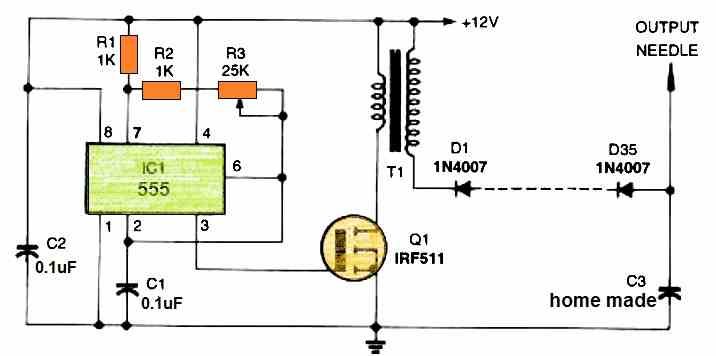
You can try the following design. You can ignore and remove diodes D1 to D35 and C3. After this you can use the secondary side to generate the required 5kV output. The T1 can be any automobile ignition coil.
Hello, I need to be sure of this before I start designing. Let take for instance, for a 2kva inverter, having this automatic charging circuit included in your circuit, won’t the transformer to high for charging a 12v 100Ah battery (assumption)?
Hello, the inverter transformer and the load must be rated to discharge the battery at 10% or 15% of its Ah rating, and thus it will charge the battery also at 10% of its Ah rating which is perfectly safe.
Thanks for answering all my questions
One last question why are RL1 and RL2 not connected anywhere from the output of the bridge rectifier ckt
The relay RL1 and RL2 what do they do as the output of the rectifier at the top is not connected anywhere
Please see the circuit diagram and the explanation, RL1 and RL2 contacts are connected with the mosfet and the transformer secondary for the changeover action
Why the rectifier is on the top of the full bridge circuit design?why we use that?
For driving the relay coils
I have couple of other questions to ask
1) what is the bridge rectifier for at the top in the circuit diagram and can a ferrite core transformer be used for this ckt at 50 hz
The bridge rectifier converts AC to DC for activating the relay coils RL1 and RL2.
Ferrite core can be used if the frequency from the oscillator circuit is over 10kHz or if the 50 Hz frequency is chopped at 10 kHz rate. However calculating the ferrite core transformer can be difficlt.
Why do we need two triangular waves to compare at lm741 to generate pwm
The two triangular waves cut each other forcing the op amp to compare the signals and generate an equivalent rectangle wave PWM at the output
Dear Sir, I noticed that transformer in UPS have 4 wires at AC section. Can you explain this ?
Dear Sarath, They could be for different AC voltage inputs such as 210V, 220V, 230V, 240V etc. This is mostly the case, however it could be different in your transformer which will need to be checked and confirmed with a meter.
Good day sir, I have search for the relay in three stat where I due buy materials and non have it. Please sir, help with another circuit that have charger maybe with spdt relay. Thanks
Michael, DPDT relay is recommended for the charger application since the contact activation must be simultaneous without a difference in timing….SPDT relay is not recommended.
hello sir at least i understood 90% so i have a question which goes like this, i saw a way that you charge a battery automatically, does it mean when you use the inverter the same time is charging and also is a way to cut off when the battery is full
Hello shafi, in the circuits explained above, you cannot use the charging and inverter mode simultaneously. When it is in the inverter mode then the charging is cut off and vice versa. A full charge cut off cannot added in these designs. A full charge cut off can be added only if an external charger is accommodated in the design.
Hello Sir, can I get inverter circuit for atx transformer but not h- bridge
If it is a center tap transformer then you can use any standard center tap based inverter circuit.
7 Simple Inverter Circuits you can Build at Home
Well sir sorry for so much disturbance. I tried to mix the battery terminal and actual it cause a damage to all my chips is there a way to protect when someone confused the terminal remain safe.
Sorry, I did not understand your question, which circuit are you referring to?
The 500w inverter with rechargerble battry
You will have to build the test circuit step wise and with proper understanding. First build and test the inverter, if the inverter works then build the relay section and check the response.
It is very important that you first understand the circuit thoroughly and only then build it, if you do it without understanding then there can be problems.
Remember RL2 relay should activate first and then RL1 with slight delay. For this delay I have put the 220uF capacitor across the RL1 coil. To increase the delay you can add a 10 ohm resistor between the RL1 coil and D5 cathode.
Sir, I heard that no matter how a modified sine wave is designed, it will not remains sine wave form when loaded. Same thing applicable to square sine wave.
I have no oscilloscope to prove this, how true of these comments?
Ayodele,
Those statements are not correct.
Hello sir, can I get 1000w circuit with charger that are simple
Hello Michael, you can easily upgrade the above design into a 1000 watt unit by adding 3 mosfest in parallel on each channl.
I understand now but if there any challenge I will let you know. Thanks Sir
Sure, no problem.
Hello Swagatam, I have designed an inverter charger like these of yours in this article relay changeover network in your design but mine is using sg3525 in the oscillator stage. Now in the amplifier stage do I have to use blocking diodes to safeguard the MOSFETs? Am using 10 MOSFETs, do I have to use 10 diodes also cross each mosfet……drain and source? Which type of blocking diodes do I use
Hello Morris, although most mosfets have an internal avalanche protection diode, it is better to add an external diode just to be safer. However, no need to add individual diodes for each mosfets, you can add a single common diode across the parallel drain/source leads of all the 10 MOSFETs. You can use 6A4 rectifier diode for this purpose.
But do I use the filter capacitor across the battery terminal as u have indicated? Advise!
Yes, a large capacitor is required since we are using a half wave rectification only for the battery charging.
Hello my teacher it’s fully automatic. Thanks for the idea. The only problem is that whn the battery fully get charged, how can it be designed to cutt off since the battery load for charging and inverter mode must pass through the center tap wire. If you have any good idea pliz I will highly appreciate.
Hello Morris, the battery charging circuits explained above are very basic designs, so an auto cut off cannot be added in it. However, if you use a 10-0-10V transformer the maximum peak voltage to the battery would be 14.1V which won’t overcharge the battery.
Ok I now want to use ups transformer 15amp. I want to use one big metal diode such that one terminal of the transformer goes direct to the battery and one other side pass through cathode and produces -14v of anode to the battery. I just want to use one metal diode. Is that in order coz I have decided to use a separate transformer and the automatic cut off circuit to get a complete automatic charger. Am trying to borrow the idea using one diode in this article. Thanks
The single diode charging system can be removed if you are using an external charger to charge the battery. The single diode and the capacitor can be removed if an external charger is being used.
Sir I was asking if I can use a single diode in an external transformer to charge the battery after removing the the diode. Let’s say we have an inverter and a separate transformer to charge the battery. In that separate transformer can a single diode charge the battery efficiently to the full charge threshold? Thanks
Morris, yes you can use a single diode with a transformer to charge a battery, but the DC won’t be efficient, and you cannot get the full power from the transformer, and you may also have to use a very large filter capacitor. Instead, it is better to use 4 diode bridge rectifier and then you can eliminate the filter capacitor entirely.
Hello sir I bought two 55ah battery that I want to use here. Can u refer me to the best float charger circuit I can build to charge for 24v if I connect the battery in series please. Secondly, does the automatic cut off circuit of the opam lm358 work for 24v too. Thanks
Hello Morris, instead of LM358 you can use an 741 by applying a zener protection at its pin#7. You can check out the following diagram which is for a 48V battery but can be also used for a 24v battery: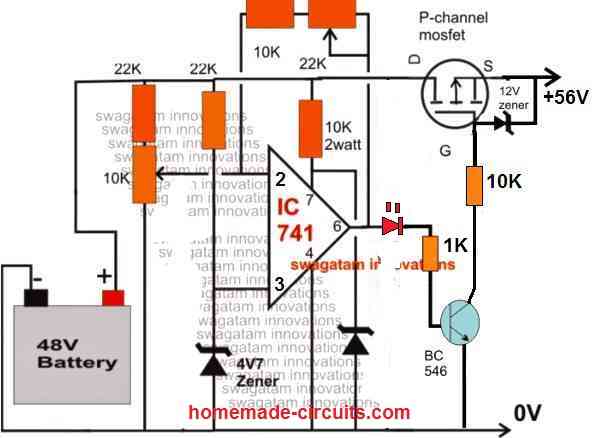
For float charging just connect a 220 ohm 1 watt resistor across drain/source of the mosfet.
If you don’t like the mosfet, you can replace it with a TIP36 transistor, with a base resistor of 1K 2 watt, and also please replace the BC547 with 2N2222
Sir can you pliz show me how I should connect the protection zena diode to pin 7 and zena should be what voltage. I beg. Secondly if the float charger is connected to the battery and is not despite reaching the charging threshold, can it damage the battery or will just keep the battery from draining?
You will nee to connect the zener diode only if the charging voltage is higher than 18 V which the 741 cannot tolerate. You can check out the diagrams discussed in the following article to know about the zener diode connections with the pin#7 of the 741 IC. If the float charging current is very low or nominal then it will not harm the battery, it will just prevent the battery from self discharge.
Simple 48V Automatic Battery Charger Circuit
Hello Swagatam, I have 200ah 12v battery and a friend brought me a variable SMPS power supply, 12v 20amp. If I tweak the preset at the corner so that it gives me 14.0v, is that safer to charge the battery because if it has no damage at that point I connect it permanently without removing to keep the battery. I want to fix it inside the inverter or advise me at what voltage is safe for it to stay connected permanently at the battery terminal. Thanks
Hello Morris, Yes you can use the 14V 20 amp SMPS to charge your 12V 200 Ah battery safely. According to my knowledge and experience if you keep the input supply slightly lower than the full charge level of the battery then there’s no need of a cut-off, especially when the current is 1/10th of the battery Ah. Therefore yes, you can safely use the 14V for charging your 12V battery without the need of any cut off at full charge level. However, the battery will be always slightly undercharged, which is not harmful for the battery.
And if for example the smps is 12v 30am do I have to replace the output transistor/mosfet with a lower rating current like 20amp to charge the 200ah battery? Or how is the current reduced
The current is generated by the SMPS transformer not the mosfet so you cannot do anything with the SMPS. In that case you will have to employ an external current limiter circuit which will limit the 30 amp to 20 amp for the battery.
Can your refer me to the current limit circuit that can be used to limit 30amp to 20amp. Thanks in advance
You can try the MOSFET based design from the following article:
https://www.homemade-circuits.com/universal-high-watt-led-current-limiter/
Then I have 500w round transformer (toroido). I also have 10 pieces of irf2805 which has a continuous current of 175amp and 330watts. How do u see if I use ten pieces in a 24v inverter u referred to me? Any disadvantage or advantage of that even in terms of power efficiency and what will be the total wattage of it? Thanks sir.
If you have a 500 watt transformer then the maximum power output you can get will be slightly less than 500 watts, no matter how many mosfets you are using. Efficiency of a center tapped iron core transformer will be around 75%.
I checked the Data sheet of irf3205 and I discovered it’s VDS to be 55v and ID as 110A . The product of the two parameters gives 6050watts. And this is used to build 500w inverter shown above. And to make 1000w inverter about 3 of that are to be added in each channel. Why is that so since 6050w should take care of 1000w load or is there any other parameter that is considered while selecting a mosfet for making inverter.
The current and the voltage specification that you are seeing are with respect to the temperature of the mosfet. The device will be able to hold the 6050 watts only if the device is maintained at 25 degrees C case temperature which is impossible even with a heatsink or water cooling. On full load as the mosfet case temperature rises above 25 degrees C, the capacity of the mosfet diminishes until it is destroyed due to overheating. This is exactly why we require many mosfets in parallel and a single mosfet does not work even though its VDS and ID ratings might look immensely high.
Ok sir. Thank you very much
Hello Swagatam, do have the best automatic charger circuit that can charge delta battery 12v 200ah. If u have tested one fully plz let me se. thanks
Hello Morris, I have posted many battery charger circuits in this website, all are good and tested. You can refer them through the following links:
Op amp Battery Charger Circuit with Auto Cut Off
Lead Acid Battery Charger Circuits
Hello my boss, can I use the first circuit using lm741 to charge the 200ah 12v battery? The first one in the 5 designs? And can I use zenar diode 6.2v instead of 6v because 6.2 is the one available here. Thanks
Hello Morris, sorry I could not understand which circuit are you referring to?
Swagatam am saying the first circuit u referred me here????????pli about the 5 high current lead acid battery charger pliz. Can I use the 6.2v zenar and 3v zena both 1watt? Secondly is mosfet with high current like 150amp good for better performance and efficiency than mosfet with low current in an inverter? I was trying to send u through that article but was not coming I don’t know y the msg not coming. Pliz advice. Thanks.
Morris, I still cannot figure out which circuit you are referring to.
Please right click on the image, “copy link address” and paste it here for me so that I can see it.
Yes higher current mosfet will mean the mosfet can work will lower amount of stress on it and therefore perform better.
how do I connect the mosfet, and the relay together?
and for the relay 1, the output is confusing me, cause I see n/c n/c
if I can get the video, I will be greatful
The relay connections are clearly shown in the diagram. The relays are DPDT type meaning each relay have two sets of contacts. Once side contacts are N/C which are shown, the opposite side contacts will be N/O which are not marked but it is understood. Let me know what exactly you can’t understand.
Dear sir give me one transformer and 2mosfet and one ic cd4047 ips with charging system circuit diagram simple and video clip thank you sir
Hello. I came across your SPWM method and wanted to make a sine for IR215З. The simulation does not work correctly, I can not find out the frequency. Did I do everything right? Can I assemble a circuit from parts? Schematic link: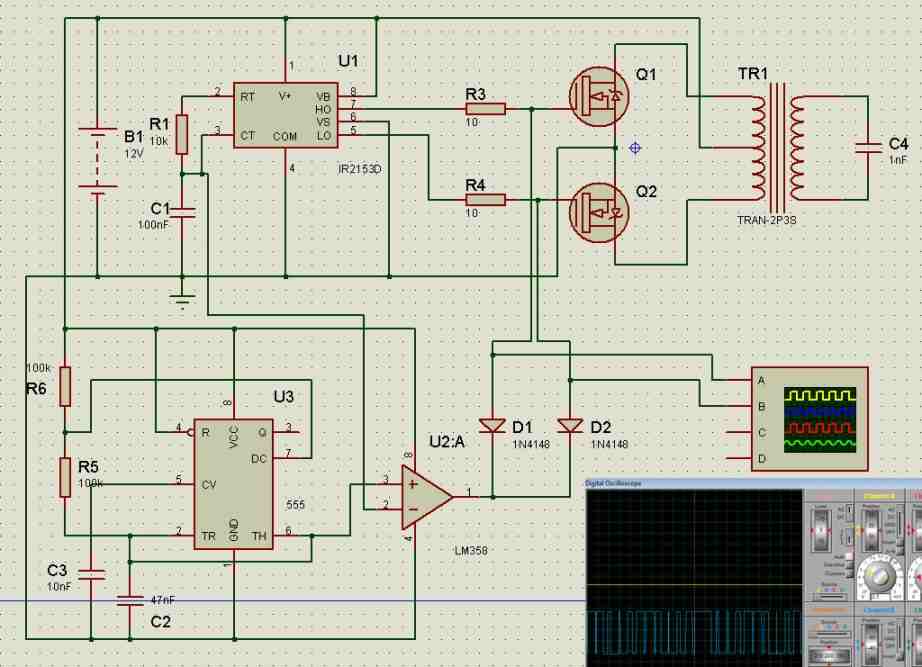
Hi, from where did you get this schematic? this not designed by me. The concept is mine, but not the precise designing.
why it is not including smoothing cap for battery charging path.
smoothing capacitor is not required for battery charging, it only needs to be a DC
Good day Mr Swagatam
Will the above circuit work for 36v brushless dc generator motor
or will there be significiant changes and what would they be.?
Thanks
Hello Wayne, the circuit is intended to produce 220V o 120V AC output, it cannot be used to operate a 36V motor, unless the transformer secondary is appropriately changed to generate 36V DC.
Good day Mr Swagatam
Thx for your reply,sorry i dont think i was very clear,what i was asking is if my input source was
a 36v dc source eg like a wind turbine instead of a 12v or 24v battery.?
would the circuit be simaliar or would it change quite a lot.
? how would i control the output over voltage of the turbine?(brushless dc motor)
I’m a mechanical person trying to learn electronics.
Thx in advance and find your site very informative.
Hello Wayne, yes the inverter will work with 36V DC, provided the transformer is also rated at 36-0-36 V. For controlling the output voltage you will need a shunt regulator as indicated in the following article:
Simple Vertical Axis Wind Turbine Generator Circuit
Please for how long will your inverter last powering a tv, and an electric fan
It will depend on the power rating of the load and the Ah rating of the battery.
I NEED SCHEMATICS FOR 2KW,1.5KW AND 1KW INVERTERS. OR A GUIDE ON WHAT TO DO IN ORDER TO UPGRADE THE LOWER ONES LIKE 500W TO THE SPECIFICATIONS ABOVE. THANKS
You can refer to the following post to know the steps for upgrading a low power inverter to a high power inverter
https://www.homemade-circuits.com/upgrading-low-power-inverter-to-high/
hi Mr: Swagatam
as I understood 10E=10 ohm is it or not?
thanks
riyahi
Hi Khoram, yes that’s correct!
Hi Mr:Swagatam
thanks for your replay.I am studying recommendations to get rid of back emf for best assembly of the circuit because I lost some 3205 without any load.all protection parts(5402 and 4148 and 1 k res. are OK. if you have any idea please help me.
riyahi
Hi Riyahi, I have tested this circuit without any protections except the diodes across drain/source, and still it worked perfectly. I had used IRF540 mosfets. You have provided multiple protections across the mosfets and yet they are burning, so it has to be examined deeply, and cannot be judged without seeing practically.
You can also try adding a 2200uF/25V across the battery terminals, which also helps to eliminate the spikes across the supply lines. Or the best idea would be to use power BJTs instead of mosfets.